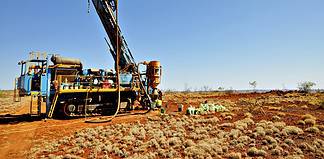AVL managing director Vincent Algar. Image: Australian Vanadium.
AUSTRALIAN Vanadium (AVL) has confirmed the economic viability of its Gabanintha project near Meekatharra in WA as one of the world’s most significant new vanadium operations. Emma Davies spoke with Australian Vanadium managing director Vincent Algar about the growing demand for vanadium batteries, the complimentary market in steel and where it fits in.
- What is the next step for the company now Gabanintha’sPre-Feasibility Study has been completed?
The results of the PFS have provided a confidence in the economic viability of the project, which enables us to push forwards towards development. We are starting the year with a diamond drilling program to extract material to scale up the test work to a pilot plant scale and prove the processing route.
Alongside this work we are continuing to drive the environmental approvals, native title approvals and analysis of the different options for project improvement that we uncovered during the PFS stage.
The completed PFS also allows us to confidently engage with strategic partners in 2019, at a time when vanadium supplies are very much in demand.
- When do you expect to the site to be operational?
Timelines are hard to provide as there are so many external factors that you can’t control, for example the environmental and native title processes – both of these are important and we respect the need for them.
We can be optimistic with our timelines and assuming all proceeds without complication we could be mining as soon as 2021. AVL’s plan is to develop the project as quickly as possible, but achieving a quality mine site with longevity built in.
- Describe how the high-grade nature of the project lends itself to low cost production?
Grade is king! In vanadium, as in many projects. The bulk grade in AVL’s case is high (more than 1 per cent vanadium oxide), compared to many deposits globally.
We use magnetic separation to ‘concentrate’ the ore. This mass recovery in the case of AVL’s project is very high (60 per cent), possibly the highest in the world.
These two factors affect many costs, they reduce the amount we have to mine and the size of the equipment we have to use to get the amount of metal we want out. This is one of the reasons we expect to be among the lowest cost producers globally.
Since each extra tonne that needs to be mined and processed adds to the cost of production, it explains why low-grades and low mass recovery projects will always struggle to stay viable through low vanadium market price points.
- What will the planned vanadium pentoxide refinery look like and what are the benefits of processing on site?
It’s important to AVL that we add value to the commodity here in Australia and generally the lowest cost method of doing that is to process it near to where it’s mined. Through the DFS stage we will be looking at what the refinery will look like and how it will be incorporated into the mine site plans.
- Take us through the complementary market in the steel sector?
Steel is actually the main market for vanadium and currently consumes the vast majority of the globally produced material. Adding vanadium to steel makes the steel stronger, but at the same time lighter. Applications range through structural steel (rebar), titanium alloys, aircraft, surgical instruments and tools.
The vanadium redox flow battery market is the complementary market and we’ve been advancing the knowledge of this through our 100 per cent owned subsidiary VSUN Energy.
- The demand for vanadium batteries is set to grow over the next few years. Where do you see the Gabanintha project fitting into this market?
AVL’s Gabanintha project will be able to produce products for both steel and energy storage. VSUN Energy was launched as part of a supply chain initiative for AVL to provide the vanadium, process it into vanadium electrolyte and either purchase batteries from existing manufacturers or manufacture our own.
- What kind of economic impact will the mine have on the Meekatharra region and the State?
AVL is engaging with the local community and interested parties in the Meekatharra area and the company is keen to have a positive impact. We are looking at upcoming roles that will be needed for the project and where we can offer training paths for local people to adopt the skills we will require. We are working with the Stephen Michael Foundation and are hoping to broaden this engagement over the coming years.
The message we hear from the people of Meekatharra is that they want jobs and they want companies to spend money in the town, not just ship people and products in. They’re seeking some support for what is a vibrant town with a great future and a lot of good people wanting to make that happen.
For the State, with the right input from the Government, which is being driven at the moment from ministers such as Bill Johnston at a State level and Linda Reynolds at a Federal level, the battery metal market should be able to do what the iron ore industry failed to do – keep some of the value of these minerals in the State and in the country.
- Where do you see AVL in the next five to 10 years?
We want to be a vanadium producer feeding both the steel and battery markets, integral to the State’s battery metal structure and also an advocate for renewable energy.
- Is there anything else you would like to add?
Vanadium is a very different metal to others and getting it into production is not a trivial process. We have built a team of experts and are engaged with external consultants who bring even more expertise. Even some of the experts have expressed surprise at the quality and size of the AVL Gabanintha project and as we analyse it further we become more and more confident of a successful outcome.








































